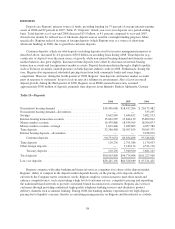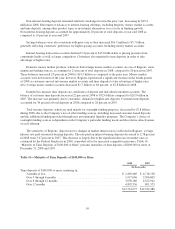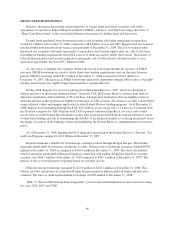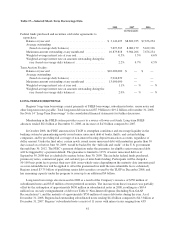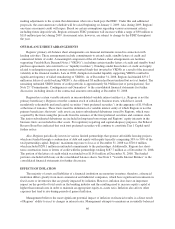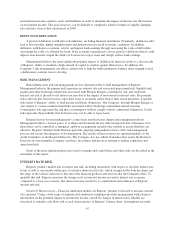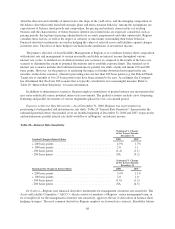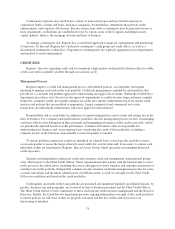Regions Bank 2008 Annual Report Download - page 76
Download and view the complete annual report
Please find page 76 of the 2008 Regions Bank annual report below. You can navigate through the pages in the report by either clicking on the pages listed below, or by using the keyword search tool below to find specific information within the annual report.making adjustments to the system that determines what rate a bank pays the FDIC. Under this and additional
proposals, the assessment rate schedule will be raised beginning on January 1, 2009. Also during 2009, Regions’
one-time assessment credit will expire. Based on certain assumptions regarding various assessment criteria,
including future deposit levels, Regions estimates FDIC premiums will increase within a range of $90 million to
$110 million (pre-tax) during 2009. Assessment rates, however, are subject to change by the FDIC throughout
the year.
OFF-BALANCE SHEET ARRANGEMENTS
Regions’ primary off-balance sheet arrangements are financial instruments issued in connection with
lending activities. These arrangements include commitments to extend credit, standby letters of credit and
commercial letters of credit. A meaningful component of the off-balance sheet arrangements are facilities
supporting Variable Rate Demand Notes (“VRDNs”), including certain standby letters of credit and standby bond
purchase agreements (also referred to as “liquidity facilities”). Fundings under these letters of credit are largely
related to redemption requests in money market mutual funds that invested in VRDNs as a result of the increased
volatility in the financial markets. Late in 2008, disruption in market liquidity supporting VRDNs resulted in
significant frequency of failed remarketing of VRDNs. As of December 31, 2008, Regions had funded $331.7
million in letters of credit backing VRDN’s. An additional $9 million had been tendered but not yet funded. The
remaining unfunded VRDN letters of credit portfolio is approximately $4.9 billion (net of participations). See
Note 25 “Commitments, Contingencies and Guarantees” to the consolidated financial statements for further
discussion, including details of the contractual amounts outstanding at December 31, 2008.
Regions has certain variable interests in unconsolidated variable interest entities (i.e., Regions is not the
primary beneficiary). Regions owns the common stock of subsidiary business trusts, which have issued
mandatorily redeemable preferred capital securities (“trust preferred securities”) in the aggregate of $1.0 billion
at the time of issuance. These trusts meet the definition of a variable interest entity of which Regions is not the
primary beneficiary; the trusts’ only assets are junior subordinated debentures issued by Regions, which were
acquired by the trusts using the proceeds from the issuance of the trust preferred securities and common stock.
The junior subordinated debentures are included in long-term borrowings and Regions’ equity interests in the
business trusts are included in other assets. For regulatory reporting and capital adequacy purposes, the Federal
Reserve Board has indicated that such trust preferred securities will continue to constitute Tier 1 Capital until
further notice.
Also, Regions periodically invests in various limited partnerships that sponsor affordable housing projects,
which are funded through a combination of debt and equity with equity typically comprising 30% to 50% of the
total partnership capital. Regions’ maximum exposure to loss as of December 31, 2008 was $710.0 million,
which included $298.1 million in unfunded commitments to the partnerships. Additionally, Regions has short-
term construction loans or letters of credit with the partnerships totaling $187.7 million as of December 31, 2008.
The portion of the letters of credit which was funded was $114.8 million at December 31, 2008. The funded
portion is included with loans on the consolidated balance sheets. See Note 2 “Variable Interest Entities” to the
consolidated financial statements for further discussion.
EFFECTS OF INFLATION
The majority of assets and liabilities of a financial institution are monetary in nature; therefore, a financial
institution differs greatly from most commercial and industrial companies, which have significant investments in
fixed assets or inventories that are greatly impacted by inflation. However, inflation does have an important
impact on the growth of total assets in the banking industry and the resulting need to increase equity capital at
higher than normal rates in order to maintain an appropriate equity-to-assets ratio. Inflation also affects other
expenses that tend to rise during periods of general inflation.
Management believes the most significant potential impact of inflation on financial results is a direct result
of Regions’ ability to react to changes in interest rates. Management attempts to maintain an essentially balanced
66




